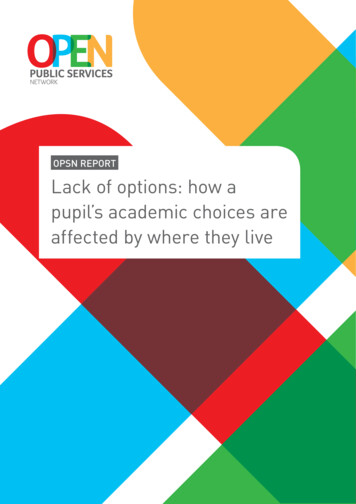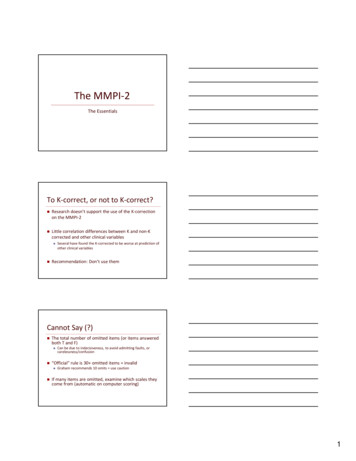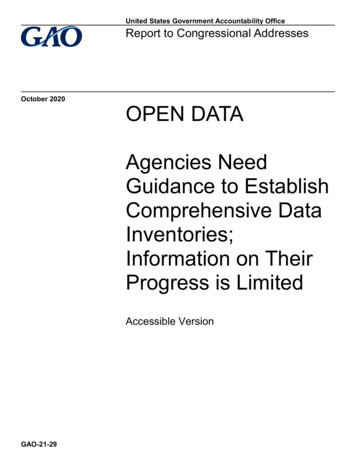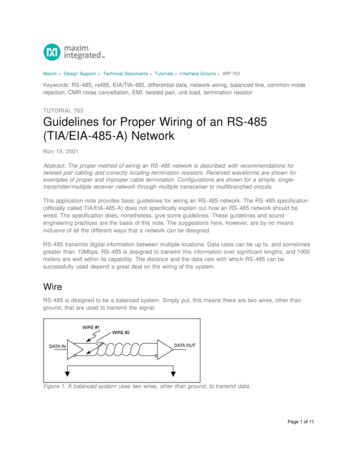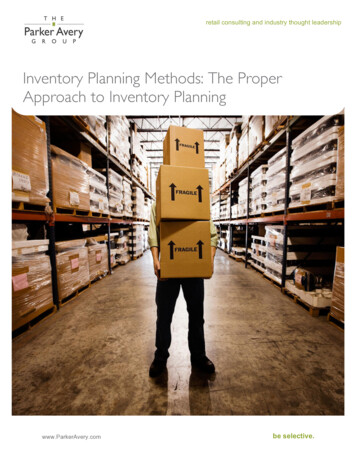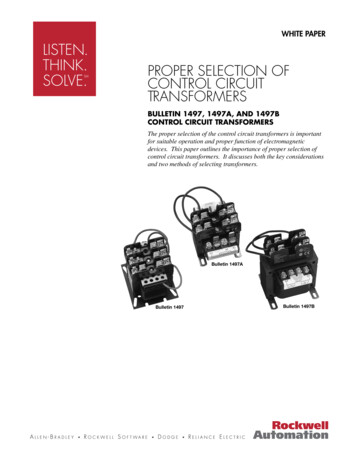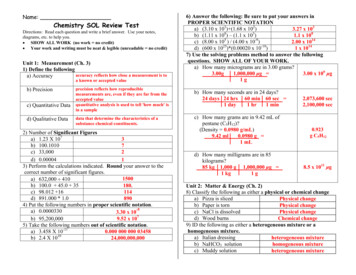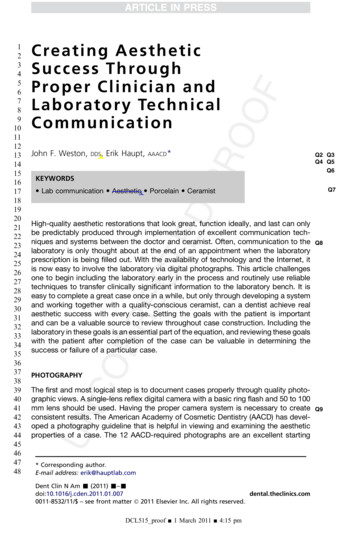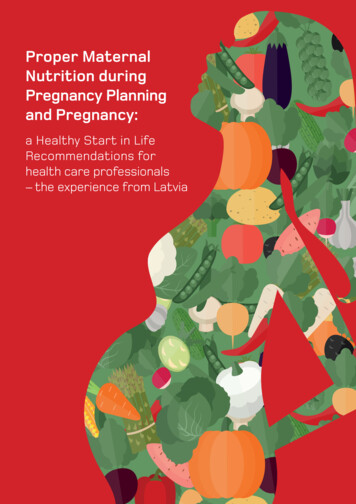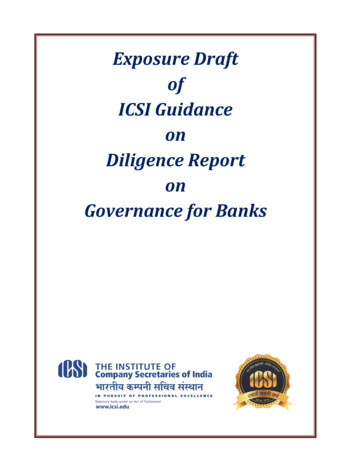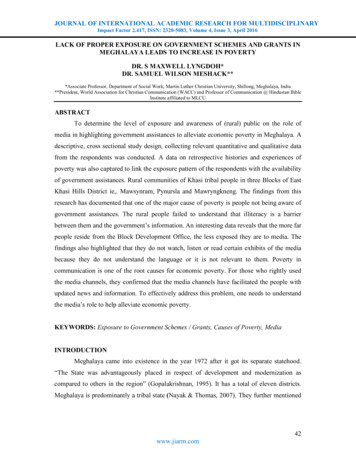
Transcription
JOURNAL OF INTERNATIONAL ACADEMIC RESEARCH FOR MULTIDISCIPLINARYImpact Factor 2.417, ISSN: 2320-5083, Volume 4, Issue 3, April 2016LACK OF PROPER EXPOSURE ON GOVERNMENT SCHEMES AND GRANTS INMEGHALAYA LEADS TO INCREASE IN POVERTYDR. S MAXWELL LYNGDOH*DR. SAMUEL WILSON MESHACK***Associate Professor, Department of Social Work, Martin Luther Christian University, Shillong, Meghalaya, India**President, World Association for Christian Communication (WACC) and Professor of Communication @ Hindustan BibleInstitute affiliated to MLCUABSTRACTTo determine the level of exposure and awareness of (rural) public on the role ofmedia in highlighting government assistances to alleviate economic poverty in Meghalaya. Adescriptive, cross sectional study design, collecting relevant quantitative and qualitative datafrom the respondents was conducted. A data on retrospective histories and experiences ofpoverty was also captured to link the exposure pattern of the respondents with the availabilityof government assistances. Rural communities of Khasi tribal people in three Blocks of EastKhasi Hills District ie,. Mawsynram, Pynursla and Mawryngkneng. The findings from thisresearch has documented that one of the major cause of poverty is people not being aware ofgovernment assistances. The rural people failed to understand that illiteracy is a barrierbetween them and the government’s information. An interesting data reveals that the more farpeople reside from the Block Development Office, the less exposed they are to media. Thefindings also highlighted that they do not watch, listen or read certain exhibits of the mediabecause they do not understand the language or it is not relevant to them. Poverty incommunication is one of the root causes for economic poverty. For those who rightly usedthe media channels, they confirmed that the media channels have facilitated the people withupdated news and information. To effectively address this problem, one needs to understandthe media’s role to help alleviate economic poverty.KEYWORDS: Exposure to Government Schemes / Grants, Causes of Poverty, MediaINTRODUCTIONMeghalaya came into existence in the year 1972 after it got its separate statehood.“The State was advantageously placed in respect of development and modernization ascompared to others in the region” (Gopalakrishnan, 1995). It has a total of eleven districts.Meghalaya is predominantly a tribal state (Nayak & Thomas, 2007). They further mentioned42www.jiarm.com
JOURNAL OF INTERNATIONAL ACADEMIC RESEARCH FOR MULTIDISCIPLINARYImpact Factor 2.417, ISSN: 2320-5083, Volume 4, Issue 3, April 2016that the State in comparison to all India situations performed better in many aspects butlagged in per capita SDP (State Domestic Product) and rural poverty.Poverty has been part and parcel of Meghalaya since it got its separate State. Developmentusually takes place at a faster rate for States that could function autonomously as independentStates. But the case is different in Meghalaya where poverty still exists after so many years ofits separate Statehood.Though a few scholars have tried to study and analyze the situation of Meghalaya in thecontext of poverty but have only been able to identify only a few of its causes. Thomas(2004) identifies the lack of technological innovations is also one of the reasons for theeconomic backwardness of the State. It may be observed that the causes of poverty couldinclude inability of the people to improve in animal husbandry or poor crop cultivation due totraditional methods of cultivation. Thomas (2004) further writes that the incidence ofunemployment (including underemployment) indicates a high incidence of poverty in theState.According to 2001 Census, about 19.6% of the population lived in urban areas. Although theState has primarily an agricultural economy and nearly 63 percent of her work force engagedin agriculture, its contribution to SDP was only 33% as against 55% by the tertiary sector(Nayak & Thomas, 2007). The Government of Meghalaya conducted two censuses of thepeople living below poverty line in 1991-92 and 1998, and estimated that the number was48.9% in 1991-92 but has increased to 54.5 % in 1998 (Saxena, 2003).Barrett and Beardmore states that since the early 1950s, Government has initiated, sustained,and refined various planning schemes to help the poor attain self sufficiency in foodproduction. The schemes have however not been very successful because the rate of povertyreduction lags behind the rapid population growth rate (as cited in India’s Urban PovertyAgenda, 2000). Thirty six per cent of the Indian population was below poverty line (BPL) in1993-94, the latest year for which the data are available and the absolute number of poor was320 million, out of which 244 million (37 per cent of the rural population) lived in rural areas(Ninth Five Year Plan, 2002).A news item reporting in Solomon Star, on the “Role of news media in poverty reductionefforts”, (2011), reads “The media is an important player - studies show that government andpublic response to poverty depends on how media frames the issue. Given the media’ssocietal responsibilities, poverty should be at the top of its reporting agenda.” The massmedia in a country like the USA, where the illiteracy is marginal, do run some programmes43www.jiarm.com
JOURNAL OF INTERNATIONAL ACADEMIC RESEARCH FOR MULTIDISCIPLINARYImpact Factor 2.417, ISSN: 2320-5083, Volume 4, Issue 3, April 2016(Sesame Street is an often cited example among TV serials) of adult literacy and socialeducation. These are for the benefit of immigrant labourers and of the poor among blacks(Raghavan, 2005). A new report by Panos London (2007), “Making poverty the story: Timeto involve the media in poverty reduction”, calls for greater involvement of the media in theefforts to tackle poverty. As the mid-point for achieving the Millennium Development Goals(MDGs) by 2015 is reached, and with the progress being in serious doubt, the time has cometo recognise and support the potentially crucial contribution of the mass media on efforts toreduce poverty.The Ninth Five Year Plan saw the implementations of many programmes and strategies tohelp alleviate poverty in rural India. While media is being examined as a tool to educate, it isalso seen as an instrument of awareness. A newspaper report entitled “Rural people unawareof Central Schemes”, (2011) mentions about the government’s lack of conducting awarenesscampaigns on the various centrally-sponsored schemes which leaves many people in the darkespecially those living in the rural areas of the State. The Planning Commission Report(2012) stated that States which included Assam, Meghalaya, Manipur, Mizoram andNagaland, poverty has increased in 2009-2010.This is perhaps one of the reasons why the media was questioned in an article “The media aswatchdog, Is anyone watching poverty?” The media was alleged that it is supposed to provideinfotaiment, if not pure entertainment, and is happy enough with the present situation(Joseph, 2011). A large section of the Indian media (particularly the electronic media) doesnot serve the interest of the people; in fact some of it is positively anti-people (Katju, 2011).He further laments, that the media often diverts the attention of the people from the realissues to non issues. In agreement to this statement, Joseph (2011) said that there is no pointexpecting anything more or better from the media, especially commercial media, becausethey are run by business enterprises pursuing profits, not trying to improve society.Katju (2008), in another article goes on to mention, “To my mind, in underdevelopedcountries such as India the media have a great responsibility to fight backward ideas such ascasteism and communalism, and help the people in their struggle against poverty and othersocial evils”. This is why Shakeel (2012), in her article opines “Society is influenced bymedia in so many ways. It is the media for the masses that helps them to get informationabout a lot of things and also to form opinions and make judgments regarding various issues”.She further lamented, “I believe, if the media identifies its responsibility and work sincerelyand honestly then it can serve as a great force in building the nation”.44www.jiarm.com
JOURNAL OF INTERNATIONAL ACADEMIC RESEARCH FOR MULTIDISCIPLINARYImpact Factor 2.417, ISSN: 2320-5083, Volume 4, Issue 3, April 2016This study aimed to determine the level of exposure and awareness of (rural) public on therole of media in projecting / highlighting government assistances to alleviate economicpoverty in Meghalaya.METHODS:This research carried out a descriptive, cross sectional study design, collectingrelevant Quantitative and Qualitative data, as well as capturing some retrospective historiesand experiences of poverty. Suitable sampling methods and appropriate data gathering toolswere then developed. Necessary permissions and consent were obtained and all ethical normswere adequately addressed.Assuming that about 40% of the households will have access to any type of media,with a confidence interval of 95% and a relative precision of 10%, therefore a minimum of808 households needs to be studied.In order to capture the prevailing communication channels and reach to thepopulation, it was proposed to take a multi stage sampling design. Multi-stage samplingrepresents a more complicated form of cluster sampling in which larger clusters are furthersubdivided into smaller, more targeted groupings for the purposes of surveying.At the first stage, Meghalaya State was chosen for the study in which East Khasi HillsDistrict was selected out of the 11 districts available. In the second stage, three Blocks wereselected based on the geographical representation out of the total number of eight blocks. Inthese blocks, villages were chosen based on the distance, which is very far off, not so far andnear to the block head quarters. This was purposively done to cover all the villages at variousdistances, which are spread across these blocks. In the final stage, systematic randomsamplings of the households were taken. One out of every ten households was taken asrespondents covering all the households in the villages systematically. This sampling wasexpected to yield a minimum sample size of how we arrive with a sample size of 808households.From each of the Blocks, the villages were segregated based on the distance from theblocks. It was proposed to select a random sample, taking into account the possible variationsdepending on the kind of exposure and accessibility they get through media. For a distancebetween 1-20 Kms, Mawryngkneng has 15 Villages, for a distance between 20-50 Kms, thereare 25 Villages, for a distance between 50-80 Kms, there are 18 Villages and for a distance of80-110 Kms, there are 6 Villages.45www.jiarm.com
JOURNAL OF INTERNATIONAL ACADEMIC RESEARCH FOR MULTIDISCIPLINARYImpact Factor 2.417, ISSN: 2320-5083, Volume 4, Issue 3, April 2016Pynursla on the other hand has 59 Villages for a distance between 1-20 Kms and 71Villages for a distance between 20-50 Kms. On a similar sample size, Mawsynram has 42Villages for a distance between 1-20 Kms, 63 Villages for a distance between 20-50 Kms and53 Villages for a distance between 50-80 Kms. This is shown in Table I (A)Table I (A) Segregation of Villages depending on the Distance from the main BlocksSl. ynursla5971-Mawrynkneng1525186The minimum sample sizes were selected taking 20% from the total number ofVillages that fall into these various categories of distance. Table I (B) shows this division.Table I (B) Sample VillagesSl. No1.2.3.4.TOTALSample 14The villages in these four categories were randomly picked determined based on thedistance. The samples for the number of households chosen were based on the systematiccalculation of 10% each from the total number of households available.Ethical IssuesApproval for the study was obtained from the University Research Ethics Committee.Informed consent was taken from the community leaders and residence of all the villages.The consent of the Block Development Officers and the employees were also taken beforethe interview was conducted or before the questionnaires were given to them for filling themup.RESULTSThe objectives of this research is to study the role of media in order to help alleviateeconomic poverty in Meghalaya by analyzing their level of awareness and exposure that therural masses can get about government schemes and grants which will help to uplift theirliving standards. The objective is also to describe the strengths and weaknesses of current46www.jiarm.com
JOURNAL OF INTERNATIONAL ACADEMIC RESEARCH FOR MULTIDISCIPLINARYImpact Factor 2.417, ISSN: 2320-5083, Volume 4, Issue 3, April 2016media to act as a prime tool to tackle rural poverty and help in bringing in socialdevelopment.Frequency of exposure of the respondents on government schemes and grants based ondistanceIn some of the major findings, 60% from the total respondents are exposed to thegovernment schemes and grants through the television only sometimes, 59% are exposed tothe government schemes and grants through the radio only sometimes and 64% are exposedto the government schemes and grants through the newspapers only sometimes. It may bementioned, that all of the above respondents reside in a distance between 20 to 50 Kilometresfrom the main Block Development Office.Exposure of the respondents in relation to the content of the information given ongovernment schemes and grants based on distance63% of the respondents are of the opinion that they do not understand much of what isbeing shown in the television, 60% are of the opinion that they do not understand much ofwhat is being broadcast in their radio sets and 50% of the respondents are of the opinion thatthey do not understand much of what they read in the newspapers in context to schemes andgrants. All the three categories of respondents are those who resides between a distances of20 to 50 Kilometres from the main Block Development Office.Exposure of the respondents in relation to the content of the information given onagriculture65% of the respondents expressed that such exposure do not give them any kind ofhelp.However, 23% others opine that such exposure has educated and broaden theirunderstanding in tackling agriculture / irrigation. This feedback has come from respondentsresiding on distances between 1 to 20 Kilometres.Exposure of the respondents in relation to the content of the information given onhealth49% of the respondents feel that they do not understand much of what is beingexposed on health benefits through these various media vehicles. However, 35% of therespondents express that such exposure to health benefits and talks have helped them to knowways and means to seek for many health benefits given by the government that can attain fortheir health care. In both the responses, significant respondents reside in distances between 1to 20 Kilometres and 20 to 50 Kilometres.47www.jiarm.com
JOURNAL OF INTERNATIONAL ACADEMIC RESEARCH FOR MULTIDISCIPLINARYImpact Factor 2.417, ISSN: 2320-5083, Volume 4, Issue 3, April 2016Exposure of the respondents in relation to guidance and counselling on local livelihoods/ guidance for entrepreneurship80% are never exposed to TV on government schemes and grants in relation toguidance and counselling on local livelihoods / guidance for entrepreneurship. However, only6% says that they are exposed to such programs everyday with the maximum number of therespondents residing between the distances of 1 to 20 Kilometres.82% are never exposed to Radio on government schemes and grants in relation toguidance and counselling on local livelihoods / guidance for entrepreneurship81% of the respondents are never exposed to Newspaper with write-ups ongovernment schemes and grants in relation to guidance and counselling on local livelihoods /guidance for entrepreneurship.Responses of the respondents in relation to the use of Mobile Phones79% said that they do not listen to radio through their mobile phones, while only 20 %of them said that they do listen to Radio using their mobile sets. It may be noted that majorityof the respondents doing so are the ones residing in the distances of 1 to 20 and 20 to 50Kilometres from the Block Development Office respectively.Responses of the respondents in relation to the causes of Poverty81% of the respondents are of the opinion that lack of awareness on governmentschemes and grants are a major cause of poverty in our society.55% of the respondents are of the opinion that poor people have hard lives becausegovernment benefits do not go far enough to help them live a decent life.87% of the total respondents said that they support the statement that people should beaware and educated about government schemes and grants to help reduce poverty.Responses of the respondents in relation to availability of Banks51% of the total number of respondents said that they do not have a Bank in theirVillages with a maximum respondents residing in a distance of 20 to 50 kilometres. 49% ofthe total number of respondents said that in order to know about the assistance provided bythe Government in terms of Loans to start a new business / to improve agriculture, theyusually discuss with their friends, neighbours and relatives.Responses of the respondents in relation to availability of job vacancies56% of the total number of respondents said that in order to know about job vacanciesin Schools / Hospitals (CHC/PHC) and in Government Offices, they approach the Headmanof the Village. While 13% others said that they usually consult the BDO for any such queries.48www.jiarm.com
JOURNAL OF INTERNATIONAL ACADEMIC RESEARCH FOR MULTIDISCIPLINARYImpact Factor 2.417, ISSN: 2320-5083, Volume 4, Issue 3, April 2016In both these categories, many of the respondents reside between distances of 1 to 20 and 20to 50 kilometres. Adding to this, the data shows that 29% of the respondents usually discussand seek information and guidance on such quires only among their friends and neighbours.DISCUSSIONYung-Ping (1966), states that economic poverty exists when the economic resourcesof a person or a family fall below what is necessary to meet the cost of a socially-determinedminimum level of living. According, to this definition, the minimum level of consumptionsocially regarded as necessary and the economic resources available for the required needsare two important elements in defining economic poverty.In this research, when asked how big a social problem is poverty in our society today,majority of the respondents agreed that it is a big social problem (Table 2). Goldstein (2006)is also of the same opinion. He states that poverty is a social problem because its effects arefelt in the society as a whole. The respondents in this research expressed that poverty is like acycle or a web. For them, having many children means having many individuals to supportand work for the family. But poverty according to them is not allowing them to send theirchildren to better schools within the villages or to nearby villages. Hence, the best way is todrop and help in household work, in agriculture and local livelihoods.The biggest cause of poverty today as reflected in the data shows that circumstancesbeyond their control cause them to be poor (Table 3). In line with this, Mahatma Gandhi saidthat poverty is not just about physical deprivation; it is also about lack of opportunity and lossof hope (poverty of spirit) (as cited in Powerful information, grassroots internationaldevelopment, n.d).The big question here is what are these circumstances that they are referring to andwhat can media do to help them get out of these situations to be able to avoid being poor? Arespondent in this research said, I have sacrificed so much to support my son
**President, World Association for Christian Communication (WACC) and Professor of Communication @ Hindustan Bible Institute affiliated to MLCU ABSTRACT To determine the level of exposure and awareness of (rural) public on the role of media in highlighting government assistances to alleviate economic poverty in Meghalaya. A
